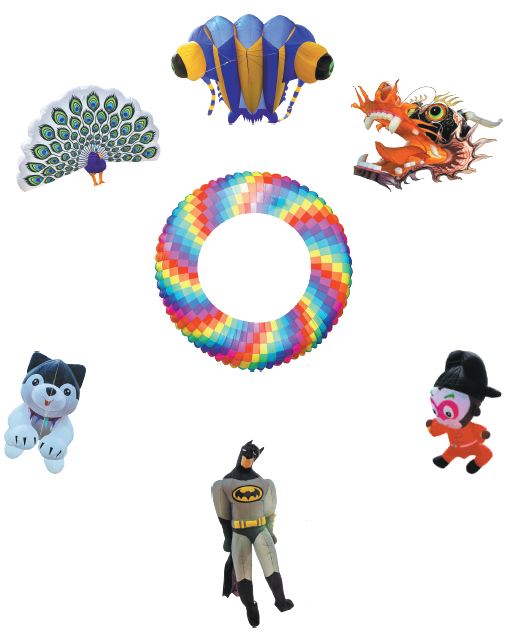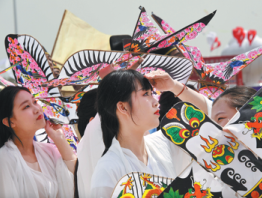KITES RISE TO FESTIVE OCCASION
Innovative designs take to the air as annual event draws thousands
As spring winds blew, a huge crowd gathered in a field in Weifang, Shandong province, looking to the skies in awe.
Overhead, a sea of colorful kites in a multitude of sizes danced — their designs featuring high-speed trains, dragons, whales, peonies and cartoon characters, among others.
One netizen commented: "In Weifang, everything you can imagine, from sea animals to dinosaurs, can fly."
The 40th Weifang International Kite Festival attracted more than 150 teams from 59 countries and regions, who sent their kites skyward for the opening ceremony on April 15. The festival lasts for about a month.
Wang Yongxun, an experienced kite maker in Weifang, attended the festival with kites designed as different types of vegetables, including Chinese cabbages, carrots and green radishes.
"Weifang is known nationwide for its vegetables, so we designed vegetable kites to salute our hometown," said Wang, who also brought along another type of kite.
Displaying the kite, Wang said: "This is a traditional fixed-wing kite, to which we added a mechanical windmill in the center. When the wind blows, the windmill rotates, resulting in two model cockerels moving as though they are fighting each other."
Stanislav Kolbintsev, who comes from Russia, was attending the festival for the first time. He brought along an innovative kite bearing the image of a traditional bird painting. It took him more than six months to make the kite.
"For me, flying kites is a lifestyle. It's important for me to attend the festival to share my hobby with friends," he said.
"I am not good at sewing, so I made the kite slowly in my free time, paying great attention to detail. It's interesting to compare the kites from different countries at the festival."
In the festival's innovative section, Zhang Huagang and more than 20 fellow team members flew a 150-meter-long kite designed as a high-speed train. Comprising a locomotive and 50 carriages, it took the team about three months to complete the kite.
"We are proud of the fast development of our country's high-speed rail network, so we designed this kite to resemble such a train to send our best wishes to the nation and the festival," Zhang said.
Wind on the opening day was perfect for Andreas Agren, who comes from Sweden, and brought a light-wind kite designed like a Viking ship to the festival.
"In Sweden, more than 1,000 years ago, merchants and warriors built ships to sail to other countries — sometimes for trading and sometimes for war. I made this kite to connect with my homeland," he said.
In one area of the field, a 300-meter-long kite with 150 strings attracted crowds of photographers. It was so long that it frequently became entangled with other kites, forcing its flyer, Ma Liping, who comes from Inner Mongolia autonomous region, to ground it.
A total of 14 kites featuring a ballet dance design also attracted considerable attention.
Each kite, which is 2 meters long and just under 1 meter wide, is controlled by four strings. Flown by 14 people from Handan, Hebei province, Shenyang, Liaoning province, and Qingdao, Shandong province, the kites were deftly controlled as the well-coordinated team members changed step, tugging at the strings to form different patterns in the air.
Team member Bai Xuedong said, "On average, it takes a year to master the basic skills needed to fly the kites in a choreographed way that ensures the strings don't become tangled.
"Flying kites is a good way to stay in shape. If the weather permits, the team, which comprises retirees, practices for several hours a day."
Statistics from the organizing committee showed that the festival attracted more than 100,000 people on the opening day.
High-tech designs
Sobraj Al Akand, who comes from Bangladesh, said: "We saw traditional kites, such as those designed like a dragon to represent China, and some really high-tech designs. Companies are also using kites to advertise themselves, which is a really nice concept."
Kites have been flown in Weifang, widely known as the world's kite capital, for about 2,400 years.
Legend has it that ancient Chinese philosopher Mozi, who was also known for his craftsmanship, made the first kite in what is now present-day Weifang. He is said to have spent three years making a wooden kite, but on the first day it flew, it fell to the ground and broke.
An ancient book states that kites were invented by Lu Ban (507-440 BC), a renowned carpenter, craftsman and engineer. A statue of Lu stands in front of the Weifang World Kite Museum, the largest such institution in the world.
Local historical records show that Weifang kites were popular during the Ming Dynasty (1368-1644) and were a major folk art in the Qing Dynasty (1644-1911), with many artists becoming widely known for their exquisite, high-flying creations.
The city's kite-making industry really took off after reform and opening-up was launched in December 1978. In 1984, kites from Weifang were sent to Shanghai for an exhibition. They impressed officials from an international kite association, who suggested that a global platform for the arts should be established in Weifang. This led to the first Weifang International Kite Festival taking place that year.
Kite lovers from a total of 11 countries and regions, including the United States, Australia, the United Kingdom, the Netherlands, Canada, Japan, New Zealand and Singapore, took part in the event.
The festival, which has since been held annually, has become a brand for the city. Many local landmarks, including the railway station, the arts center and street lamps, feature butterfly-shaped kite designs.
Thanks to the city's long and illustrious history, Weifang kites were listed as a national intangible cultural heritage in 2006.
A typical Weifang kite is made from bamboo and features Chinese painting. Traditional kite-making focuses on the four arts of tying (using bamboo for a frame), pasting (placing paper, silk and other material onto the frame), painting and "letting go" (flying).
Skills inherited
Yang Hongwei, 57, is a leading inheritor of the city's tradition. Born into a kite-making family, Yang grew up in the company of brightly colored kites of different shapes and sizes, which her grandfather made in his workshop.
She started to learn kite-making skills from her grandfather when she was 16, and after practicing the craft for 10 years, Yang set up her own workshop in 1992.
Her creations include butterfly and swallow patterns, as well as designs and images from Chinese mythology, legends and history.
This year, Yang made a 52-meter-long kite painted with a dragon's head. She added to it paintings of 100 zhuangyuan (candidates who finished in top place over the years in annual national-level recruitment exams for officials in ancient China).
Yang has traveled to countries such as Germany, Australia and New Zealand to share Chinese stories related to kites and to teach the traditional craft of making them.
"Many parts of the world have a tradition of flying kites, but I think our kites have a unique cultural background," she said.
Zhang Jianwei, director of the comprehensive service center at the Weifang International Kite Association, said, "The city's kites account for more than 75 percent of the international kite market and nearly 85 percent of the domestic market."
More than 600 kite companies are based in Weifang — employing over 80,000 people. The association said these companies generate annual sales of over 2 billion yuan ($290 million).
Wangjiazhuangzi village in Weifang is known as the "No 1 Kite Village in China".More than 100 local enterprises are engaged in kite-making, with many villagers processing fabric and the hand-held line wheels used to fly the kites.
Wang Tieyuan, deputy director of the city's kite association, said: "The annual kite festival has helped the village expand its markets. We expect to sell 90 million kites this year."
More than half the villagers work in the kite industry or related sectors, Wang said, adding that many farmers also take part in this business when they have the time.
From design and raw materials to accessories, the village has formed a relatively complete industrial chain.
In recent years, villagers have used e-commerce platforms to increase sales. Each year, more than 40 million kites from Wangjiazhuangzi are sold worldwide via such platforms.
Kites have provided a platform for Weifang to boost development in various fields, ranging from promoting rural vitalization to spurring the city's overseas trade.
Kite-flying has also become a popular pursuit in Weifang, with local residents frequently seen flying their kites in squares and in fields set aside for the activity.
Zhang said, "We will hold regular activities for free to enable young people to experience this activity and better acquaint them with kites."
zhaoruixue@chinadaily.com.cn

Kites designed as a dog, a peacock, a trilobite (above, an extinct marine arthropod), a dragon's head, the Monkey King, Batman and a colorful circle rise to the sky at the Weifang International Kite Festival in Shandong province. HAN JIAJUN/FOR CHINA DAILY/LI ZIHENG/SUN SHUBAO/XINHUA

Visitors look to the skies at the kite festival in Weifang, Shandong. LI ZIHENG/XINHUA










